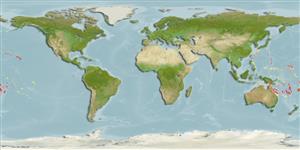Environment: milieu / climate zone / depth range / distribution range
Ecología
marino asociado a arrecife; rango de profundidad 2 - 15 m (Ref. 13227). Tropical
Southwest Pacific: Australia to New Caledonia, Fiji, then east to Tonga, Niue and American Samoa.
Tamaño / Peso / Age
Maturity: Lm ? range ? - ? cm
Max length : 3.5 cm SL macho / no sexado; (Ref. 54980)
Short description
Claves de identificación | Morfología | Morfometría
Espinas dorsales (total) : 14 - 18; Radios blandos dorsales (total) : 6 - 10; Espinas anales: 2; Radios blandos anales: 18 - 21. Dorsal profile steep with very short snout; head and preopercular area naked; slender supraorbital tentacle; first dorsal fin a third of the height of second dorsal fin; body coloration gray with 5 indistinct, broad, paired brown bars; uneven bright orange spots on head and anterior body, small posteriorly, and mostly orange on posterior margins of scales; caudal-fin with black base, gray center with a midlateral orange band, a thin white margin, black submarginal line, and a wide bright red-orange arc. Dorsal rays III + XI-XV + 6-10; lateral line discontinuous, 21-22 + 17-19; mandibular pores 3 + 2 + 3 (Ref. 54980).
Eggs are hemispherical and covered with numerous sticky threads that anchor them in the algae on the nesting sites (Ref. 240). Larvae are planktonic which occur primarily in shallow, nearshore waters (Ref. 94114). Minimum depth from Ref. 58018.
Life cycle and mating behavior
Maturities | Reproducción | Spawnings | Egg(s) | Fecundities | Larva
Fricke, R., 1994. Tripterygiid fishes of Australia, New Zealand and the southwest Pacific Ocean (Teleostei). Theses Zool. 24:1-585. (Ref. 13227)
IUCN Red List Status (Ref. 130435)
Threat to humans
Harmless
Human uses
Pesquerías: sin interés
Herramientas
Special reports
Download XML
Fuentes de Internet
Estimates based on models
Preferred temperature (Ref.
123201): 24.9 - 29.4, mean 27.6 °C (based on 700 cells).
Phylogenetic diversity index (Ref.
82804): PD
50 = 0.7500 [Uniqueness, from 0.5 = low to 2.0 = high].
Bayesian length-weight: a=0.00562 (0.00258 - 0.01228), b=3.08 (2.89 - 3.27), in cm total length, based on LWR estimates for this (Sub)family-body shape (Ref.
93245).
Nivel trófico (Ref.
69278): 3.1 ±0.3 se; based on size and trophs of closest relatives
Resiliencia (Ref.
120179): Alto, población duplicada en un tiempo mínimo inferior a 15 meses (Preliminary K or Fecundity.).
Fishing Vulnerability (Ref.
59153): Low vulnerability (10 of 100).
Nutrients (Ref.
124155): Calcium = 479 [180, 1,873] mg/100g; Iron = 2.37 [0.84, 5.41] mg/100g; Protein = 18.2 [16.4, 19.9] %; Omega3 = 0.0987 [, ] g/100g; Selenium = 60.9 [11.7, 256.0] μg/100g; VitaminA = 44.9 [6.3, 314.5] μg/100g; Zinc = 5.64 [2.49, 10.53] mg/100g (wet weight);
